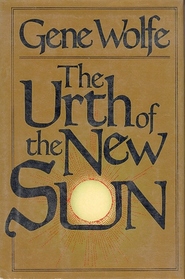Helpful Score: 1
The New Sun: A Story of Redemption, January 21, 2005
Reviewer: Daven "A Reading Fool" (Samut Prakarn, Thailand)
The underlying allegory in the Book of the New Sun is the story of the redemption of one man- Severian- and all men and women on Urth, as represented by him. It is an intentional irony of the story that when Severian embarks on this final odyssey he is already more than one person himself, from his experiences previously; and indeed those inside him form part of the process of saving his (and thus the Urth's) soul.
Those who read this story as a straightforward space opera will probably be puzzled and confused. However, as a spiritual pilgrimage and tale of the human condition, pain, and forgiveness, it is without parallel as far as I know in the science fiction genre (and with few parallels in any other genre).
The clever connections with Hebrew and Christian mythology continue to run beneath the surface of the story, and if it wasn't already clear from Severian's monologue in the earlier books about God being a torturer, too, it becomes evident in this book that Severian is a literary Christ figure- though one of the most bizarre and fragmented I have come across, and certainly one of the greater and so more human ones.
The delight in following this myth is only increased by Wolfe's admirable, unshakable dedication to real science. The evolution of the even more fantastic part of the New Sun Universe shown to us in this additional novel continues to be hinted at and explained in terms of the real world, though shrouded in myth and awe.
Those who fail to understand the strength of the ending would be well advised to go back to the earlier novels and re-read the script of the play Severian performs in the Autarch's gardens.
Reviewer: Daven "A Reading Fool" (Samut Prakarn, Thailand)
The underlying allegory in the Book of the New Sun is the story of the redemption of one man- Severian- and all men and women on Urth, as represented by him. It is an intentional irony of the story that when Severian embarks on this final odyssey he is already more than one person himself, from his experiences previously; and indeed those inside him form part of the process of saving his (and thus the Urth's) soul.
Those who read this story as a straightforward space opera will probably be puzzled and confused. However, as a spiritual pilgrimage and tale of the human condition, pain, and forgiveness, it is without parallel as far as I know in the science fiction genre (and with few parallels in any other genre).
The clever connections with Hebrew and Christian mythology continue to run beneath the surface of the story, and if it wasn't already clear from Severian's monologue in the earlier books about God being a torturer, too, it becomes evident in this book that Severian is a literary Christ figure- though one of the most bizarre and fragmented I have come across, and certainly one of the greater and so more human ones.
The delight in following this myth is only increased by Wolfe's admirable, unshakable dedication to real science. The evolution of the even more fantastic part of the New Sun Universe shown to us in this additional novel continues to be hinted at and explained in terms of the real world, though shrouded in myth and awe.
Those who fail to understand the strength of the ending would be well advised to go back to the earlier novels and re-read the script of the play Severian performs in the Autarch's gardens.




